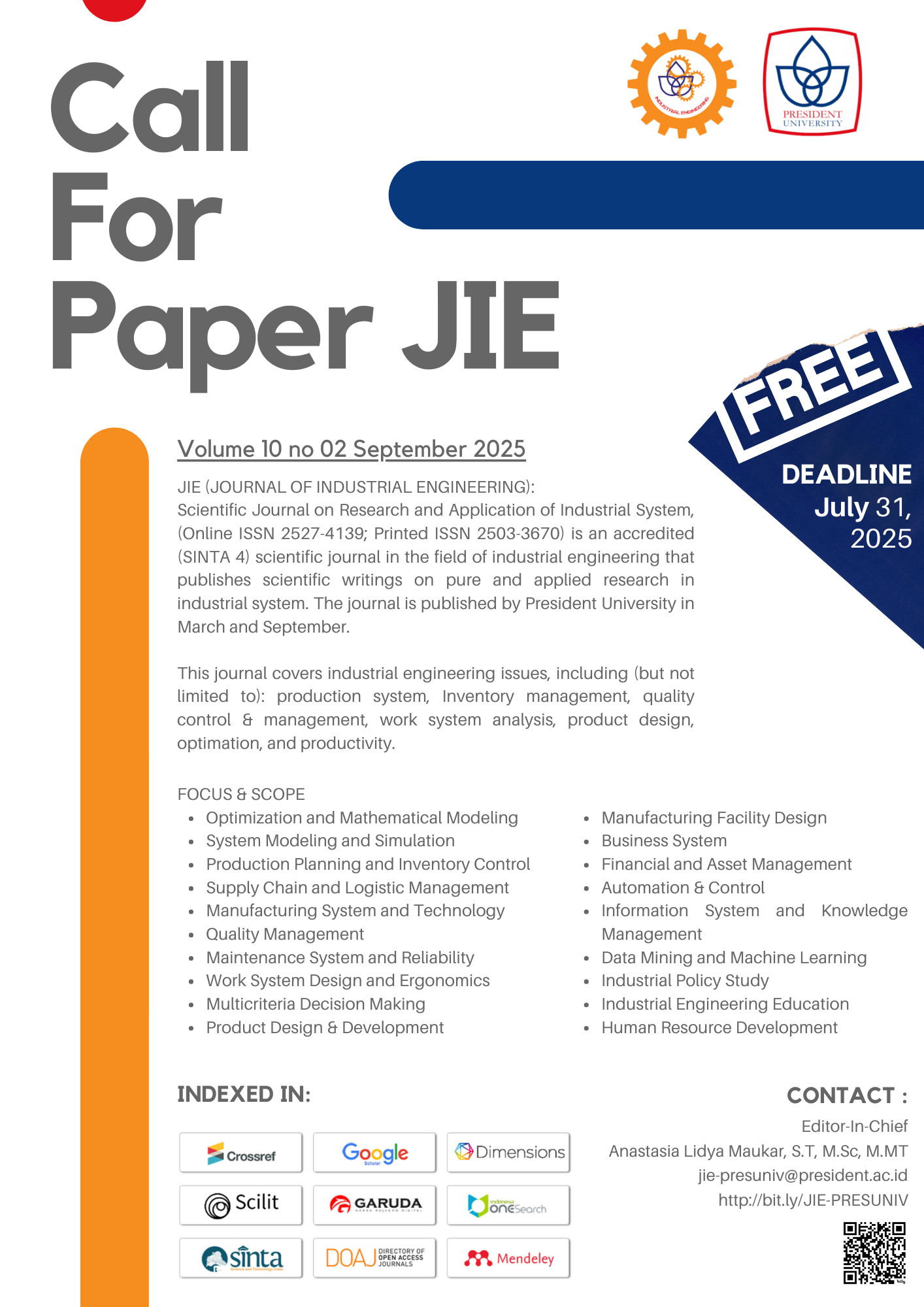Perbaikan Tata Latek Gudang Bahan Baku Resin PT. Bina Adidaya
DOI:
https://doi.org/10.33021/jie.v10i01.76Keywords:
Class based storage, Dedicated storage, FIFO, Randomized storageAbstract
Expiry date or expiration date is the date listed on the packaging of a product, indicating the deadline set by the manufacturer to ensure product quality. Not only products but also raw materials have expiration dates. Manufacturers strive to produce high-quality products for consumers, necessitating the use of high-quality raw materials before their expiration dates. Raw materials should be used in the order of arrival, as earlier arrivals typically have earlier expiration dates. Therefore, a first-in-first-out (FIFO) system is crucial in raw material procurement for production processes. PT. Bina Adidaya, a manufacturing company established in 1990, produces various types of paint products. The company has implemented a FIFO system for raw material procurement, but challenges arise due to the increasing number of raw material types, leading to storage buildup. To facilitate FIFO implementation, a planning system for new raw material placement is necessary. Three methods are considered for this planning: dedicated storage, randomized storage, and class-based storage. Based on calculations, the optimal combination is a longitudinal layout with a class-based storage method, offering a storage capacity of 248 pallets and a total displacement distance of 29,665 meters. The current raw material service level is 98.51%. With the proposed improvements, this level is expected to reach 100%.
References
Abdul, F. W., & Ramadhan, M. R. (2020). Analisis Pengaruh Layout Penyimpanan Bahan Baku terhadap First In First Out Berdasarkan Hasil Jajak Pendapat Karyawan (Studi pada PT Indofood CBP Sukses Makmur TBK Divisi Packaging Purwakarta). Jurnal Logistik Indonesia, 4(2), 114-126. https://doi.org/10.31334/logistik.v4i2.1113
Aliudin, T. M. A., Ilhami, M. A., & Febianti, E. (2015). Usulan perbaikan tata letak gudang produk drum oli menggunakan metode dedicated storage di pt xyz. Jurnal Teknik Industri Untirta, 3(1).90-97 .https://dx.doi.org/10.36055/jti.v3i1.359
Arifin, M. S. (2024). Layout Design by Comparing Dedicated Storage Method and Class-Based Storage Method of Spare Parts Warehouse at Phthalic Anhydride (PA) Company. SITEKIN: Jurnal Sains, Teknologi dan Industri, 21(2), 282-292. http://dx.doi.org/ 10.24014/sitekin.v21i2.29752
Fadillah, M. R., & Fahma. (2023). F. Re-Layout Design of the Kalus 1.6 Warehouse Using the Class-Based Storage Method at PT XYZ. Performa: Media Ilmiah Teknik Industri, 22(2), 158-167. https://doi.org/10.20961/performa.22.2.82225
Hapsari, A. R., & Handayani, N. U. (2017). Usulan Perbaikan Perancangan Tata Letak Warehouse Bahan Mentah Cv. mebel International Berdasarkan Kriteria Komiditi Similarity. Industrial Engineering Online Journal, 6(1). Retrieved from https://ejournal3.undip.ac.id/index.php/ieoj/article/view/15938
Harma, B., & Sudra, H. I. (2020). Analisa Perbaikan Tata Letak Penempatan Bahan Bakudi Area Gudang Penyimpanan. Jurnal Teknologi, 10(2). 15-21. https:// doi.org/10.35134/jitekin.v10i2.21
Hasibuan, Y. M., Syarif, A. A., Walady, D., Pratama, R., & Hasibuan, H. A. H. (2022). Perbandingan Metode Shared Storage Dan Metode Dedicated Storage Pada Penempatan Dan Penyusunan Barang Di Gudang Spareparts Pt Indonesai Asahan Aluminium (Persero). Jurnal Simetri Rekayasa, 4(1), 279-281.
Heragu, S. S. (2018). Facilities design. CRC Press
Johan, J., & Suhada, K. (2018). Usulan Perancangan Tata Letak Gudang Dengan Menggunakan Metode Class-based storage (Studi Kasus Di Pt Heksatex Indah, Cimahi Selatan). Journal of Integrated System, 1(1), 52-71. https://doi.org/ 10.28932/jis.v1i1.989
Jumali, M. A., Maulidah, A. R., & Utomo, Y. (2022). Rearranging First-In First-Out (FIFO) Parts Layouts. PROZIMA (Productivity, Optimization and Manufacturing System Engineering), 6(2), 137-142. https://doi.org/10.21070/prozima.v6i2.1580
Kumara, F. I., & Majid, N. (2024). Pengaruh Tata Letak Produk terhadap Kapasitas Penyimpanan dan Efektivitas Pengemasan pada CV. YUMMYS MOTHERLACTO INDONESIA. Jurnal Pengabdian Masyarakat Indonesia (JPMI), 1(6), 10-20. https://doi.org/ 10.62017/jpmi
Novrianto, T. F., Andesta, D., & Jufriyanto, M.(2024). Proposed Layout of Spare Parts Warehouse with Class Based Storage Policy Based on ABC Analysis at PT. XYZ. G-Tech: Jurnal Teknologi Terapan, 8(2), 975–984. https://doi.org/10.33379/gtech.v8i2.4110
Nur, H. M., & Maarif, V. (2018). Perencanaan Tata Letak Gudang Menggunakan Metode Class-Based Storage-Craft Pada Distributor Computer & Office Equipment. Jurnal Evolusi, 6(2), 36-42. https://doi.org/10.31294/evolusi.v6i2.4425
Pranata, V., & Santoso, S. (2022). Facility Layout Design of New Warehouse and Implementation of Multi-Criteria Decision Making for Product Allocation at PT XYZ. Opsi, 15(1), 64-76. https://doi.org/10.31315/opsi.v15i1.6684
Prasetyaningtyas, A., Herlina, L., & Ilhami, M. A. (2013). Usulan Tata Letak Gudang Untuk Meminimasi Jarak Material Handling Menggunakan Metode Dedicated Storage. Jurnal Teknik Industri Untirta, 1(1). 29-34. https://dx.doi.org/10.36055/jti.v1i1.114
Rahayu, E. A., & Silitonga, R. Y. (2024). Perbaikan Tata Letak Gudang PT PYT dengan memperhatikan Jarak, Waktu Handling, dan Utilitas Ruang Penyimpanan. Journal of Integrated System, 7(1), 31-51. https://doi.org/10.28932/jis.v7i1.8678
Rondonuwu, G., Pangemanan, S. S., & Mawikere, L. M. (2016). Evaluasi penerapan metode persediaan berdasarkan metode FIFO pada PT. Honda Tunas Dwipa Matra Manado. Jurnal EMBA: Jurnal Riset Ekonomi, Manajemen, Bisnis dan Akuntansi, 4(4).268-278. https://doi.org/10.35794/emba.4.3.2016.13720
Shiau, J. Y., & Huang, J. A. (2020). Wave planning for cart picking in a randomized storage warehouse. Applied Sciences, 10(22), 8050. https://doi.org/10.3390/ app10228050
Sufa, M. F., & Mulyana, M. K. (2021, April). Spare Part Warehouse Management Analysis Using 5S Approach and FIFO System. In Proceeding of International Conference on Science, Health, And Technology (pp. 318-322). https://doi.org/10.47701/icohetech.v1i1.1149
Winursito, Y. C., Qurratu’aini, N. I., & Saputro, A. (2023, November). Penerapan Relayout Dengan Menggunakan Metode Class Based Storage di PT SMM. In Prosiding Seminar Nasional Waluyo Jatmiko (pp. 541-550). https://doi.org/10.33005/wj.v16i1.78
Downloads
Published
Issue
Section
License
Copyright (c) 2025 Trifenaus Prabu Hidayat, Andre Sugioko

This work is licensed under a Creative Commons Attribution-NonCommercial-ShareAlike 4.0 International License.

















